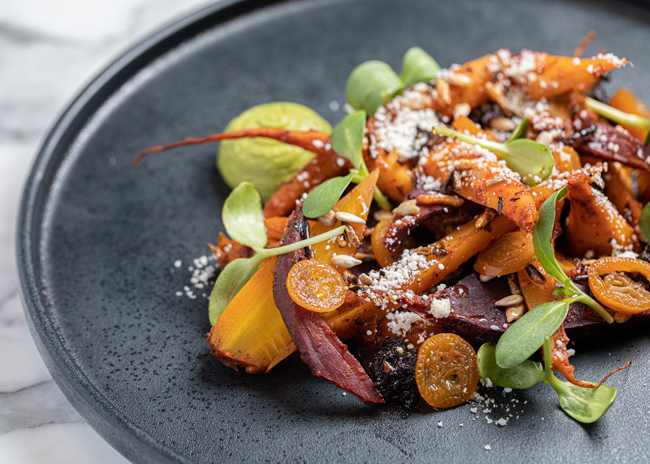With food costs on the rise, making the most of every ingredient may be worth the effort.
Root-to-stem and zero-waste cooking approaches incorporate produce trimmings in stocks, sauces and purees as well as in entrees, sides and even desserts. The principle remains the same regardless of the term: Use everything. Foodservice operators use the entire fruit or vegetable, discarding nothing.
Savings Breakdown
For every $1 restaurants invest in programs to reduce kitchen food waste, they will save, on average, $7 in operating costs due to buying less food, according to the report “The Business Case for Reducing Food Loss and Waste: Restaurants” by Champions 12.3, a coalition of executives from governments, businesses, international organizations, research institutions and civil society. Operators benefit by lowering waste management costs.
 Carrots Al Pastor
Carrots Al Pastor
Rethinking Waste
Ways to reimagine produce components in recipes:
Asparagus stems: blanch, boil, saute, grill, roast or fry for use in salads, pasta, soups and other dishes
Broccoli stalks: spiralize or peel into strips for slaws and stir-fries
Carrot tops: use as an herb, fry as a garnish or include as a salad ingredient
Cauliflower stems: puree for soups and sauces; or steam or roast for eating
Radish leaves: cook for use in pesto
Strawberry tops: use for water infusions
Concept Close-Up: Travelle at The Langham, Chicago
 Chef Jeff Vucko, Travelle at The LanghamWith vegetable scrap-filled pasta, polenta created from mushroom scraps and risotto made with parsley pulp, Chef de Cuisine Jeff Vucko at Travelle at The Langham hotel was one of the pioneers of root-to-stem cooking. Here, he provides insight into what’s involved with this zero-waste method.
Chef Jeff Vucko, Travelle at The LanghamWith vegetable scrap-filled pasta, polenta created from mushroom scraps and risotto made with parsley pulp, Chef de Cuisine Jeff Vucko at Travelle at The Langham hotel was one of the pioneers of root-to-stem cooking. Here, he provides insight into what’s involved with this zero-waste method.
Q: What’s the philosophy behind root-to-stem cooking?
A: The concept of root-to-stem cooking is a similar, if not the same, philosophy as having zero waste from your product. Root-to-stem and nose-to-tail cooking have similar ideals: Respect the product from seed to harvest to the plate. When using actual roots, like carrots, for example, you may prepare them cooked, raw, roasted, juiced, etc. But then you still have the shaved parts of the carrot you could throw into your stocks. The green tops can be used as garnishes or turned into a carrot-top pesto.
Q: Are there ingredients that lend themselves to zero waste?
A: The most common foods for this would come from root vegetables like radishes, carrots, beets and turnips.
Q: What are the advantages of this cooking method?
A: The benefits include [adding nutrition], money savings and creativity. This way of cooking should be a philosophy most, if not all, chefs believe in. Limiting our waste is never easy. Challenging yourself as a chef to learn new preservation techniques is the noble thing to do. I believe in climate change and hear firsthand from our farmers the changes that they are dealing with. Respecting their products and making them shine is one of my team’s goals. This way of cooking should continue to grow in concert with vegetarianism.
Root-to-Stem Prep Equipment Checklist:
Blender
Food processor
Mixer
Immersion blender
Food strainer
Slicer with shoot accessory
Dicer
Mandolin
Wedger
Commercial peele




